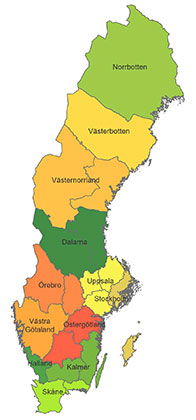Assessment of environmentally hazardous activities
The County Administrative Board handles applications for permits for environmentally hazardous activities. It is then the Environmental Assessment Delegation that makes decisions in these cases.
The assessment of applications for permits for environmentally hazardous activities is handled by the County Administrative Board. As a rule, the application documents are public records. Administrators at the County Administrative Board prepare the case and the Environmental Assessment Delegation (EAD) makes the decision. Among other things, they decide on
- permits and authorisations to make changes
- amendments to the terms and conditions of a permit
- final terms and conditions after a probationary period
- extended probationary periods
- extended start-up periods
- revocation of permits
- approval of bank guarantees.
The EAD is an independent part of the County Administrative Board and consists of a chairperson, who is a law graduate, and an environmental expert.

Environmental Assessment Delegations can be found in 12 counties - Norrbotten, Västerbotten, Västernorrland, Dalarna, Uppsala, Stockholm, Örebro, Västra Götaland, Östergötland, Kalmar, Halland and Skåne.
How does the application process work?
- When you apply for a permit for environmentally hazardous activities, the assessment always starts with a consultation between your representative(s) and the County Administrative Board (among others).
- The next step is for you to submit the application for a permit together with an environmental impact assessment to the Environmental Assessment Delegation (EAD).
- The EAD usually sends out the application and environmental impact assessment on a supplementary round, so that interested parties can review whether they consider the application to be complete. If the EAD finds that the documents need to be supplemented, they will send you an injunction about the supplementary information that your application requires.
- Once the EAD considers the documents in the case to be complete, it usually provides public notice about the application. The delegation then sends the case back to the interested parties for another review. The interested parties must then assess whether they consider that the application can be granted and whether specific terms and conditions should be decided regarding the activities in question. If you apply for a permit, you will always have the opportunity to respond to the opinions submitted in the case.
- After that, it is time for EAD to make a decision.
Consultation
When you need to apply for a permit for an environmentally hazardous activity, you must always start by producing a consultation document and then carry out a consultation. You must consult the County Administrative Board, the municipality, the relevant authorities, neighbours and other interested parties. As the party applying for the permit, you are the one responsible for the consultation.
When producing your application and environmental impact assessment, you should take the comments you received during the consultation into account. A well-conducted consultation increases the chance that you will succeed in submitting a complete application and environmental impact assessment that do not require supplementation. This makes the handling of your case more efficient and shortens the processing time.
The minimum required content of the consultation document is outlined in Sections 8-9 of the Environmental Assessment Regulation.
Investigation consultation or demarcation consultation? Or both?
The consultation process depends on the environmental impact of the activity in question. Certain activities must always be assumed to have a significant environmental impact. For other activities, it is the County Administrative Board that decides whether or not they should be assumed to have a significant environmental impact.
If you wish to apply for a permit for a type of activity that is not always assumed to have a significant environmental impact, you can start with an investigation consultation. The purpose of the investigation consultation is partly to investigate whether or not the activity has a significant environmental impact, and partly to obtain viewpoints on what the application and the environmental impact assessment should contain. After that, the County Administrative Board must assess whether or not the activity can be assumed to have a significant environmental impact.
If the activity is assumed to have a significant environmental impact, you must conduct a demarcation consultation. The purpose of that consultation is to discuss the content of the more comprehensive environmental impact assessment that you must produce in such a case.
Application and environmental impact assessment
Once the consultation has been completed, you must produce your application and environmental impact assessment and submit them to the Environmental Assessment Delegation. In the documents, you should take into account the views that have emerged during the consultation.
The minimum content of the application and the environmental impact assessment are set out in Chapters 6 and 22 of the Environmental Assessment Regulation and the Regulation on Environmentally Hazardous Activities and Health Protection.
Among other things, an application must include
- administrative details
- activity codes
- applicable decisions under the Environmental Protection Act/Environmental Code and other laws
- proposed conditions, commitments and proposals for safeguard measures
- proposals for the monitoring and inspection of activities
- a technical description, with drawings, production quantities, information about the conditions on the site
- description of the best possible techniques for minimising environmental impact. Various options must be presented, along with a description of their effects and costs
- data on energy consumption, emission sources, the amount of foreseeable emissions and proposals for measures to prevent the generation of waste
- information on resource efficiency and recycling issues
- status report and BAT conclusions for activities governed by the Industrial Emissions Directive (IED)
- safety report or plan of action under the Seveso Act for the activities concerned
- environmental impact assessment and report on the consultation(s)
- alternative location assessment (if the activity is assumed to have a significant environmental impact).
If the application is not complete, the Environmental Assessment Delegation will inform you about what supplementary information is needed.
The e-services and forms of the County Administrative Board in this field are not available in English. If you wish to submit an application or notification, you may contact the County Administrative Board, which can inform you how to proceed.
Guidance for your application
Animal husbandry activities
The guidance provides examples of what should be included in an application and an environmental impact assessment for the authorisation to perform animal husbandry activities.
Quarries
Guidance on quarries can be found on the websites of the Swedish Environmental Protection Agency (Naturvårdsverket) and the Geological Survey of Sweden (Sveriges geologiska undersökning).
The Swedish Environmental Agency’s guidance on quarries External link.
External link.
Assistance in applications for gravel and rock quarries, Geological Survey of Sweden External link.
External link.
Public notice of the application
Once the application and the environmental impact assessment are complete, the Environmental Assessment Delegation (EAD) provides public notice about them in the local newspapers and on the website of the County Administrative Board. If you apply for a permit, you are responsible for the cost of publishing such announcements. The EAD also sends the documents to the interested parties for review. They will then have the opportunity to comment, for example on whether the application can be granted or whether any specific terms or conditions are necessary for the activities. If you apply for a permit, you will have the opportunity to respond to the opinions that are received.
Decision
It is the EAD that makes a decision in the case. Those affected by the decision can appeal it to the Land and Environment Court. The court decides who is affected by the decision and has the right to appeal.






